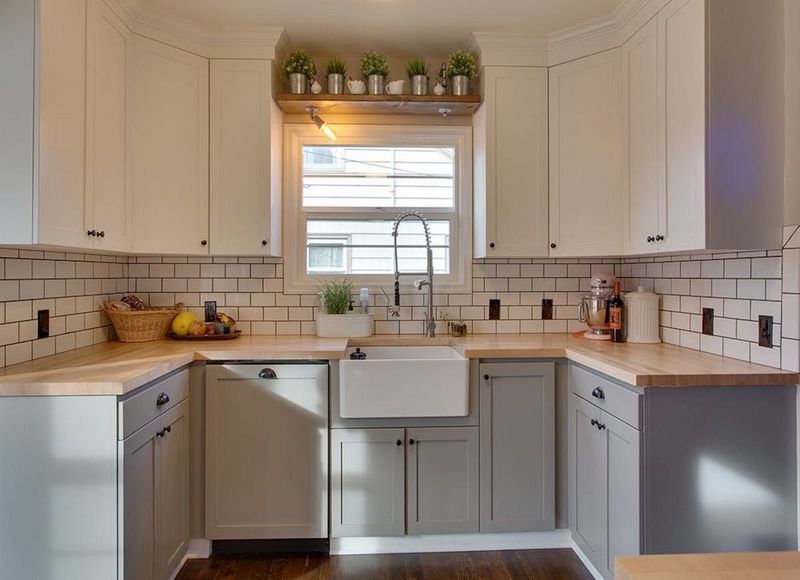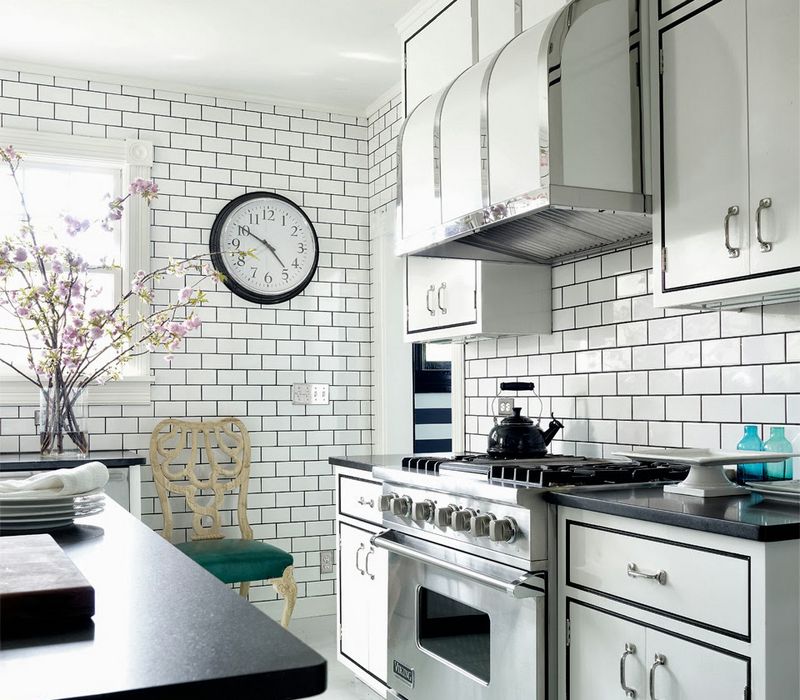
All About Subway Tile
Subway tile is a popular choice for both bathroom and kitchen installations. Its classic and timeless design has made it a staple in many homes. With its clean lines, rectangular shape, and uniform size, subway tile can create a sleek and modern look on any wall.
One of the reasons subway tile is so versatile is its ability to be laid in various patterns. From the traditional brick pattern to herringbone or basketweave, the possibilities are endless. These patterns can add visual interest and depth to any space.
When it comes to grout, subway tile offers opportunities to experiment with color and texture. Choosing a contrasting grout color can highlight the pattern and make the tile pop. On the other hand, matching the grout color to the tile can create a seamless and monochromatic look.
Whether you’re renovating a bathroom or redesigning a kitchen, subway tile is a timeless choice that can elevate the design of any space. Its clean and classic aesthetic, along with its versatility in patterns and grout options, make it a favorite among homeowners and designers alike.
What is Subway Tile?
Subway tile is a type of ceramic or porcelain tile that is commonly used in bathroom and kitchen design. It gets its name from the tile pattern used in the New York City subway system in the early 20th century, which featured rectangular tiles arranged in a brick-like pattern on the walls.
Subway tile is known for its classic and timeless look, making it a popular choice for many homeowners and designers. It is often used to create a sleek and clean aesthetic in a space, but can also be paired with other materials and styles to create a more eclectic or vintage look.
Installation of subway tile is relatively simple, as it is usually sold in individual pieces that can be easily arranged and installed on a wall. The most common size of subway tile is 3 inches by 6 inches, but other sizes, such as 4 inches by 8 inches or 2 inches by 4 inches, are also available.
When installing subway tile, it is important to consider the spacing and alignment of the tiles. Traditionally, subway tile is installed with a small gap between each tile, which is then filled with grout. This grout helps to create a uniform and seamless look, as well as providing protection for the underlying wall.
Subway tile can be used in a variety of ways in both bathrooms and kitchens. In bathrooms, it is often used to create a classic and clean look on the walls or as a backsplash behind a vanity or bathtub. In kitchens, subway tile is commonly used as a backsplash behind the sink or stove, but it can also be used to cover entire walls or create an accent wall.
History of Subway Tile
The history of subway tile dates back to the early 20th century when it was first used in the construction of subway stations in New York City. The tiles were popularized by architect George C. Heins and Christopher Grant La Farge, who were hired by the Metropolitan Transportation Authority to design the subway stations.
Originally, subway tile was made of white glazed ceramic and had a rectangular shape, measuring around 3 inches by 6 inches. These dimensions were specifically chosen to create a clean and uniform look in the stations. The smooth surface of the tile made it easy to clean, making it an ideal choice for high-traffic areas like subway platforms and stations.
Subway tile quickly gained popularity and soon found its way into residential buildings. It was widely used in bathrooms and kitchens due to its durability and timeless design. The simplicity of the tile allowed for various patterns to be created, including the classic brick pattern and herringbone pattern.
Over time, subway tile has evolved to include a variety of colors, sizes, and materials. While white ceramic subway tile remains the most popular choice, there are now options in different colors, such as black, gray, and even bold hues like blue and green. Additionally, subway tile is now available in different sizes, including larger tiles that can create a modern and sleek look.
When it comes to installation, subway tile is typically laid in a brick pattern, with each row offset by half the width of the tile. The tiles are usually installed with grout in between to create a classic look, although some modern designs use very thin grout lines or even substitute grout with epoxy or other materials.
Today, subway tile continues to be a popular choice in both residential and commercial spaces. Its timeless design, versatility, and durability make it a staple in bathroom and kitchen design. Whether used in a traditional or contemporary setting, subway tile adds a touch of elegance and sophistication to any space.
Types of Subway Tile
Subway tile is a versatile option for adding a classic and timeless look to any space. With its clean lines and simple design, subway tile can be used in various patterns and installations to create different looks. Here are some popular types of subway tile:
- Basic Subway Tile: This is the standard rectangular tile that is typically used in subway stations. It is available in various sizes, but the most common size is 3×6 inches. This type of tile is perfect for creating a sleek and minimalist design.
- Herringbone Pattern: Herringbone is a popular pattern that creates a zigzag effect by laying the tiles at a 45-degree angle. This pattern adds visual interest and can make a wall or floor stand out.
- Vertical Stacked Pattern: Instead of the traditional horizontal installation, subway tiles can also be installed vertically. This creates a unique and modern look that can elongate the walls and make the space appear taller.
- Subway Tile with Colored Grout: To add a pop of color and make the subway tile more visually interesting, colored grout can be used. This technique allows you to create a statement wall or backsplash in your kitchen or bathroom.
- Subway Tile with Accent Tiles: Mixing subway tile with accent tiles can create a custom and unique design. By adding a row or section of accent tiles, you can introduce color or pattern to the wall and make it more visually appealing.
Whether you prefer a classic or modern look, subway tile offers endless possibilities for design. Its versatility and timeless appeal make it a popular choice for bathrooms, kitchens, and other wall applications. Consider the different patterns, installations, and design elements to find the perfect subway tile option for your space.
Popular Subway Tile Patterns
Subway tiles are a popular choice for covering walls in both bathrooms and kitchens. They are known for their rectangular shape, usually measuring 3×6 inches, and their versatility in design. One of the key aspects of using subway tiles is the selection of the grout color. It can be matched to the tile color for a seamless look or contrasted to create an eye-catching effect.
Here are some popular subway tile patterns:
- Classic Stacked: This is the most common and timeless pattern. The tiles are aligned in straight rows, both horizontally and vertically. The simplicity of this pattern makes it suitable for any style of decor.
- Brickwork: In this pattern, the subway tiles are installed in a staggered fashion, resembling the pattern of a brick wall. This adds a touch of visual interest and depth to the wall.
- Herringbone: The herringbone pattern involves arranging the tiles in a V-shaped pattern, creating a zigzag effect. This pattern adds an element of sophistication and can make a wall stand out.
- Diagonal: In the diagonal pattern, the subway tiles are laid at a 45-degree angle. This creates a unique look and can make a small space appear larger by visually elongating the walls.
- Vintage Basketweave: This pattern combines subway tiles with smaller accent tiles to create a woven effect. The accent tiles are typically square or hexagonal and add a vintage touch to the design.
When choosing a subway tile pattern for your space, consider the overall design and style you want to achieve. Experimenting with different patterns and grout colors can help you create a unique and personalized look.
Choosing the Right Grout for Subway Tile
When it comes to installing subway tile on your bathroom or kitchen wall, choosing the right grout is crucial for both functionality and aesthetics. Grout is the material that fills in the gaps between the tiles, and it plays an important role in the overall look and durability of your tile installation.
Matching or Contrasting: One of the first decisions to make when choosing grout for your subway tile is whether you want it to match or contrast with the color of the tiles. Matching grout creates a more seamless and cohesive look, while contrasting grout can add visual interest and highlight the individual tiles.
Consider Tile Patterns: The pattern in which you install your subway tiles can also influence the grout decision. If you choose a classic brick pattern with the tiles arranged in offset rows, a matching grout may enhance the uniformity of the pattern. On the other hand, if you opt for a herringbone or chevron pattern, a contrasting grout can help emphasize the unique design.
Grout Type: There are several types of grout available, including cement-based grout, epoxy grout, and urethane grout. Cement-based grout is the most common choice and is suitable for most subway tile installations. Epoxy grout is more durable and resistant to stains, making it a great option for high-traffic areas or areas prone to moisture. Urethane grout offers similar benefits to epoxy grout but is easier to work with during installation.
Grout Color: Grout comes in a wide range of colors, allowing you to customize the look of your subway tile installation. When choosing a grout color, consider the overall color scheme of your bathroom or kitchen. Lighter grout colors tend to blend in more with the tiles, while darker grout colors can make a bold statement and may require more maintenance to keep clean.
Final Thoughts: Choosing the right grout for your subway tile installation is an important decision that can greatly impact the overall look and longevity of the project. Consider factors such as matching or contrasting, tile patterns, grout types, and grout colors to create a stunning and functional tile installation for your space.
Advantages of Using Subway Tile
Subway tile has become a popular choice for homeowners and designers to use in their kitchens, bathrooms, and other spaces. This classic tile design offers several benefits that make it a practical and stylish choice for any wall or surface.
- Timeless Design: Subway tile is known for its timeless design. This tile pattern has been around since the early 20th century and has continued to be a popular choice for many years. Its simple and clean lines give it a classic and versatile look that can complement any design style.
- Variety of Colors and Patterns: Subway tile comes in a wide range of colors and patterns, allowing you to choose the perfect option for your space. Whether you prefer a classic white tile or want to add a pop of color with a bold pattern, subway tile offers endless possibilities for customization.
- Easy Installation: Subway tile is relatively easy to install, making it a practical choice for DIY enthusiasts or homeowners on a budget. The rectangular shape and uniform size of subway tiles allow for quick and efficient installation, saving both time and money.
- Durability: Subway tile is known for its durability and can withstand heavy use in high-traffic areas. Its glazed surface makes it resistant to stains, scratches, and water damage, making it an ideal choice for kitchens and bathrooms.
- Easy to Clean: The smooth and non-porous surface of subway tile makes it easy to clean. A simple wipe with a damp cloth or a mild cleaning solution is usually enough to maintain its appearance and keep it looking fresh.
Overall, subway tile offers a combination of classic design, versatility, durability, and easy maintenance that make it an excellent choice for any space. Whether you’re renovating your kitchen or updating your bathroom, subway tile is a reliable option that will add style and functionality to your walls or surfaces.
Disadvantages of Using Subway Tile
While subway tile is a popular choice in many home designs, it does have some disadvantages to consider before making your decision. Here are a few drawbacks to using subway tile:
- Limited design options: Subway tile is known for its simple, rectangular shape. While this can be a classic and versatile look, it may not offer the variety of patterns and shapes that some homeowners desire.
- Installation challenges: Installing subway tile can be more labor-intensive compared to other types of tiles. The individual tiles need to be laid out carefully to create the desired pattern, which can be time-consuming and require a skilled installer.
- Grout maintenance: Subway tile often requires grout, which can be difficult to keep clean, especially in high-traffic areas like the kitchen or bathroom. The grout lines may need frequent cleaning and sealing to prevent staining and dirt buildup.
- Cost considerations: While subway tile is generally affordable, the costs can add up depending on the size of the project. The cost of the materials, installation, and any additional features like accent tiles or trim can contribute to the overall expenses.
Despite these disadvantages, subway tile remains a popular choice for many homeowners due to its timeless appeal and versatility. By weighing the pros and cons, you can make an informed decision about whether subway tile is the right fit for your design project.
Cleaning and Maintenance of Subway Tile
Proper cleaning and maintenance of subway tile can help keep it looking beautiful and extend its lifespan. Here are some tips to help you keep your subway tile installation in great condition:
Regular Cleaning
Regular cleaning is essential to prevent dirt and grime from building up on your subway tile walls. Use a mild, non-abrasive cleaner and a soft cloth or sponge to wipe down the tile regularly.
Avoid Harsh Cleaners
Avoid using harsh cleaners or abrasive tools on your subway tile, as they can damage the surface. Stick to mild cleaners that are safe for use on tile.
Grout Cleaning
Grout lines can easily accumulate dirt and grime, so it’s important to keep them clean. Use a grout cleaner and a grout brush to scrub away any stains or discoloration. Regularly sealing the grout can also help prevent staining.
Prevent Stains
Be proactive in preventing stains on your subway tile. Wipe up any spills or splatters immediately to prevent them from seeping into the tile or grout and causing stains.
Avoid Harsh Scrubbing
While it’s important to keep your subway tile clean, avoid harsh scrubbing as it can scratch the surface. Use gentle, circular motions when cleaning to avoid damaging the tile.
Inspect for Damage

Regularly inspect your subway tile for any signs of damage, such as cracks or chipped edges. If you notice any issues, it’s important to address them promptly to prevent further damage.
Design Considerations
When choosing subway tile for your kitchen or bathroom design, consider the color and pattern that will be easiest to maintain. Light-colored tiles and simple patterns can help to hide dirt and stains more effectively.
By following these tips for cleaning and maintenance, you can ensure that your subway tile installation remains beautiful and durable for years to come.
Subway Tile in Different Rooms
In recent years, subway tile has become a popular choice for homeowners and designers alike. Its timeless and versatile design makes it suitable for a variety of rooms, including the bathroom.
In the bathroom, subway tiles can be used to create a clean and classic look. With their rectangular shape and beveled edges, these tiles can add depth and dimension to any space. They are commonly used to cover the walls of the shower or bathtub area, but they can also be used to create a statement wall behind the vanity or as a backsplash.
When it comes to installation, subway tiles can be laid in various patterns, such as the traditional brick pattern or the herringbone pattern. These patterns can add visual interest and create a unique design element in the bathroom.
Another advantage of subway tiles is their ease of maintenance. The smooth and glossy surface of these tiles makes them easy to clean, and they are resistant to water and stains. They are also durable and long-lasting, making them a great choice for a high-traffic area like the bathroom.
Subway tiles come in a wide range of colors, including white, gray, and black. This allows homeowners to choose a color that complements their bathroom’s color scheme and overall design. It’s important to consider the color of the grout when selecting subway tiles, as it can greatly impact the final look. Contrasting grout can create a bold and dramatic effect, while matching grout can give a seamless and cohesive look.
Overall, subway tiles are a versatile and stylish choice for any room in the house, including the bathroom. Whether used as a feature wall or as a full wall covering, these tiles can add a touch of elegance and sophistication to any bathroom design.
Cost of Subway Tile
When it comes to subway tile, the cost can vary depending on a few different factors. These factors include the type of tile you choose, the size of the area you need to cover, and the complexity of the installation.
Type of Tile: Subway tile comes in a variety of materials, such as ceramic, porcelain, and glass. The cost of each type can vary significantly. Ceramic subway tile is usually the most affordable option, while glass subway tile tends to be the most expensive.
Size of Area: The size of the area you need to cover with subway tile will also impact the cost. Larger areas will require more tile, which can increase the overall cost. It’s important to measure the area accurately to determine how much tile is needed.
Installation: The cost of installation can vary depending on the complexity of the design and the skills of the installer. If you’re planning to install the subway tile yourself, you can save money on labor costs. However, if you’re not experienced with tile installation, it’s recommended to hire a professional to ensure a quality result.
Patterns: Different patterns can be created with subway tile, such as traditional brick or herringbone. More complex patterns may require additional tile cuts and can increase the cost of the project.
Bathroom vs. Kitchen: The cost of subway tile can also vary depending on the location where it will be installed. Bathrooms often have more intricate designs and smaller areas compared to kitchens. This can make bathroom installations more expensive than kitchen installations.
In summary, the cost of subway tile can vary based on the type of tile, the size of the area, the complexity of the installation, the chosen pattern, and the location. It’s important to consider all of these factors when budgeting for a subway tile project.
Installation Process of Subway Tile
Installing subway tile can be a great way to enhance the design of your kitchen or bathroom. Its classic and versatile look makes it a popular choice among homeowners. Here is a step-by-step guide on how to install subway tile.
- Prepare the wall: Before starting the installation process, make sure the wall is clean and free of any debris. This will ensure that the tile adheres properly.
- Measure and plan: Measure the area where you want to install the subway tile and plan the layout. This will help you determine the number of tiles you need and help you visualize the final design.
- Apply adhesive: Use a trowel to apply tile adhesive to the wall. Spread the adhesive in an even layer, making sure to cover the entire area.
- Start tiling: Begin the tiling process by placing the first subway tile at the bottom center of the wall. Press it firmly into the adhesive, making sure it is level.
- Create patterns: To add interest to your design, consider creating patterns with the subway tile. You can alternate the direction of the tile or use a different colored tile for a more unique look.
- Continue tiling: Working from the bottom up, continue placing the subway tiles on the wall. Use tile spacers to maintain even gaps between the tiles.
- Cut tiles: Use a tile cutter or a wet saw to cut tiles as needed to fit the edges of the wall or around objects such as outlets or switches.
- Apply grout: Once all the tiles are in place and the adhesive has dried, remove the tile spacers and apply grout. Use a grout float to spread the grout over the tiles, filling the gaps between them.
- Clean the tiles: After the grout has set for a few minutes, use a damp sponge to clean the excess grout from the surface of the tiles. Rinse the sponge regularly to prevent smearing.
- Finishing touches: Finally, wipe the tiles with a dry cloth to remove any remaining haze. Inspect the tiles for any loose or uneven ones and make any necessary adjustments.
By following these steps, you can successfully install subway tile in your kitchen or bathroom. Whether you choose a classic white subway tile or opt for a more colorful design, subway tile is a timeless choice that can transform any space.
Subway Tile vs. Other Tile Options
When it comes to choosing the perfect tile option for your kitchen or bathroom, there are a variety of options to consider. One popular choice is subway tile, known for its timeless and versatile design. However, it’s important to explore all tile options before making a decision. Here, we will compare subway tile to other tile options to help you make an informed choice for your space.
- Installation: Subway tile is relatively easy to install and can be done by homeowners with some DIY experience. Other tile options, such as mosaic or patterned tiles, may require more skill and precision during the installation process.
- Kitchen Versatility: Subway tile is a popular choice for kitchen backsplashes due to its clean and classic look. It pairs well with various kitchen design styles and colors. Other tile options, such as mosaic or ceramic tiles, can also be used in kitchen designs, but may offer a more eclectic or specific look.
- Bathroom Elegance: Subway tile is a popular choice for bathroom walls and showers due to its sleek and elegant design. Its simplicity allows for various patterns, such as herringbone or vertical stack bond, to be created. Other tile options, such as porcelain or glass tiles, can also be used in bathroom designs to create a luxurious and personalized space.
- Grout Considerations: Since subway tile is typically larger in size, there is less grout required during installation. This can make cleaning and maintenance easier compared to other tile options, such as penny or mosaic tiles, which have smaller pieces and more grout lines.
- Design Flexibility: While subway tile has a classic and timeless design, it may not offer as much design flexibility as other tile options. Mosaic, patterned, or textured tiles can add more visual interest and depth to a space.
In summary, subway tile is a versatile and popular option for kitchens and bathrooms due to its timeless design, ease of installation, and minimal grout lines. However, it’s important to consider other tile options to ensure you choose the best option for your specific design preferences and needs.
Subway Tile in Modern Interior Design
In recent years, subway tile has become increasingly popular in modern interior design. Subway tile is a type of ceramic or porcelain tile that is commonly used on kitchen and bathroom walls. Its name comes from its origin in the early 20th century, when it was used in the New York City subway system. Today, subway tile is known for its simple yet stylish design that can add a touch of vintage charm to any space.
One of the main benefits of subway tile is its versatility in design. It can be installed in various patterns, such as the traditional horizontal brick pattern or the popular herringbone pattern. These patterns can create a unique and visually interesting look in any room. Additionally, subway tile can be paired with different grout colors to further enhance its design. For example, using dark grout with white subway tile can create a striking contrast and modern aesthetic.
Subway tile is particularly well-suited for kitchens and bathrooms due to its easy maintenance and durability. It is resistant to stains and water damage, making it an ideal choice for areas that are prone to spills and moisture. Additionally, the smooth surface of subway tile makes it easy to clean with just a damp cloth or sponge.
When it comes to installation, subway tile is relatively straightforward. It is typically installed using a thin-set mortar or adhesive, and then grouted to fill in the gaps between the tiles. The size and shape of subway tile also make it easy to work with and cut to fit any space. This allows for flexibility in design and ensures a seamless and professional-looking installation.
In conclusion, subway tile is a versatile and practical choice for modern interior design. Its timeless design, easy maintenance, and durability make it a popular option for kitchens and bathrooms. Whether used in a classic brick pattern or a more unique herringbone design, subway tile can add a touch of sophistication and style to any space.
Where to Buy Subway Tile
If you’re looking to add a touch of classic design to your kitchen or bathroom, subway tile is a great choice. Its simple yet elegant style has been popular for decades and continues to be a staple in many homes. But where can you buy subway tile?
There are several options available to you when it comes to purchasing subway tile. Here are a few places to consider:
- Home Improvement Stores: Home improvement stores like Home Depot and Lowe’s often have a wide selection of subway tile in various colors and sizes. They can be a convenient option for those who want to see the tile in person before making a purchase.
- Tile Specialty Stores: Tile specialty stores may offer a larger selection of subway tile compared to home improvement stores. They can provide expert advice on tile selection and installation.
- Online Retailers: There are numerous online retailers that sell subway tile. This can be a convenient option for those who prefer to shop from the comfort of their own home. Be sure to read customer reviews and check return policies before making a purchase.
When choosing the right subway tile for your kitchen or bathroom, there are a few factors to consider:
- Material: Subway tile can be made from various materials including ceramic, porcelain, and glass. Consider the durability and maintenance requirements of each material.
- Color: Subway tile is commonly available in white, but it can also be found in a range of other colors. Consider how the color will fit into your overall design scheme.
- Size: Subway tile is typically rectangular with a size of 3×6 inches. However, there are also other sizes available, such as 2×4 inches or larger format tiles.
Once you have chosen your subway tile, it’s important to consider the grout color and installation. The grout color can have a significant impact on the overall look of the tile installation. Additionally, proper installation techniques are crucial for ensuring the longevity and durability of the subway tile.
In conclusion, subway tile can add a timeless and elegant look to any kitchen or bathroom. Whether you choose to purchase subway tile from a home improvement store, tile specialty store, or online retailer, be sure to consider the material, color, and size of the tile. And don’t forget to carefully consider the grout color and installation for a seamless and polished finish.
Questions and answers:
What is subway tile?
Subway tile is a type of rectangular ceramic or porcelain tile that was originally used in subway stations in the early 20th century. It is known for its simple and timeless design, with a smooth surface and beveled edges.
What sizes are available for subway tile?
Subway tile is typically available in sizes of 3×6 inches, 4×8 inches, and 4×12 inches. However, there are also smaller and larger sizes available for more unique designs.
Can subway tile be used in bathrooms?
Yes, subway tile is a popular choice for bathrooms due to its classic look and versatility. It can be used on walls, showers, and even bathroom floors. It is also easy to clean and maintain.
What are the different patterns in which subway tile can be installed?
Subway tile can be installed in various patterns, such as the traditional running bond pattern, herringbone pattern, basket weave pattern, or even in a vertical or diagonal pattern. The choice of pattern can greatly impact the overall look of the space.
Is subway tile suitable for kitchen backsplashes?
Yes, subway tile is a popular choice for kitchen backsplashes due to its clean and streamlined look. It can be installed in a simple horizontal or vertical pattern, or even in a more intricate pattern like herringbone to add visual interest to the space.
What is subway tile?
Subway tile is a type of ceramic tile that was originally used in the New York City subway system. It is typically a rectangular shape, measuring 3 inches by 6 inches, and is known for its clean, simple appearance.






